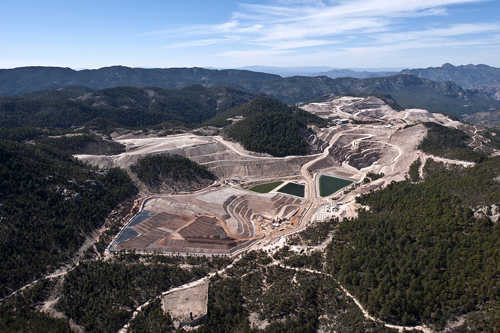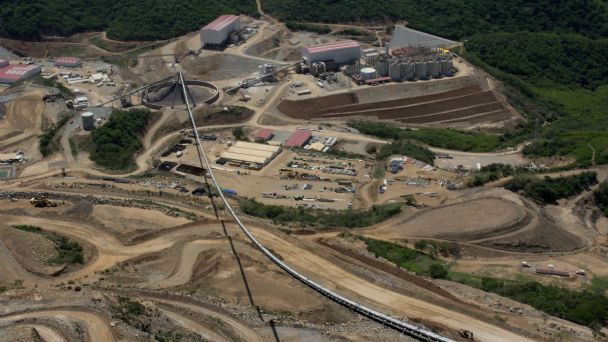
Though its mining history may span close to 500 years and counting, Mexico remains a major mineral exploration ground and retains its position amongst the world’s largest metal producers. The country’s rich geology and favourable regulations has made it an epicentre for mining activity, not least it is mountainous northern region, home to the legendary Sierra Madre gold and silver belt. It is here, 220 kilometres west of Chihuahua, where one finds the Pinos Altos mine.
An open-pit and underground mining operation, Pinos Altos, including the nearby stand-alone Creston Mascota pit and heap leach operation, has proven and probable reserves of approximately 2.7 million ounces of gold and 74.4 million ounces of silver. The mine itself was acquired in 2006, by Toronto-based company Agnico-Eagle, an international gold producer, with operating mines in Canada, Finland and Mexico.
Pinos Altos is Agnico-Eagle’s first mine in Mexico. Open pit mining began there in 2008 from the Santo Niño pit, and an underground mine beneath the pit began production in 2010. It poured its first gold in July 2009 from the Santo Niño heap leach, and in September from the mineral processing plant, achieving commercial production in November 2009.
Pinos Altos is expected to produce 159,000 ounces of gold as well as by-product silver in 2013, and to average 148,000 ounces of gold per year from 2014 to 2015, with a mine life through 2029. In addition, Creston Mascota is expected to pour 32,000 ounces of gold in 2013 and to average 54,000 ounces of gold per year from 2014-2015, with an expected mine life to 2018.
Surface mining at Pinos Altos is carried out at the Santo Niño and Oberon de Weber pits, and, in future, the San Eligio and El Apache pits. Mining is by conventional open pit methods, using shovels and trucks to remove around 17 million tonnes of ore and waste material each year.
Meanwhile, the underground mining method is sub-level stoping, used to extract ore from the Santo Niño, Cerro Colorado, Oberon de Weber and San Eligio deposits. This ore is subsequently trucked to surface via a ramp system. At current maximum production, the underground mine can provide 3,000 tonnes of ore per day. Shaft-sinking began in 2012 to increase the underground production capacity to 4,500 tonnes per day. This will better match the mine capacity to the mill, which is operating at more than the design of 4,000 tonnes per day.
Most of the ore from Pinos Altos is treated in a process plant, with the lower grade ore heap-leached. The conventional, 4,000-tonne per day process plant includes crushing, grinding, gravity concentration and agitated leaching, followed by counter-current decantation. Gold and silver are recovered using the Merrill-Crowe method, and a refinery produces gold and silver doré bars on site. Metals recovery in the plant is estimated at 93 percent for gold and 50 percent for silver over the life of the mine.
Additionally, the Creston Mascota facility is responsible for mining an average of 4,000 tonnes of ore per day by employing the same surface mining method as that used at Pinos Altos. All the Creston Mascota ore is processed using heap-leaching. The heap leach facility is similar to the Pinos Altos facility, but here the precious metals are recovered by a small carbon column circuit. The gold and silver is stripped from the carbon in the Pinos Altos plant and then poured as doré bars, with expected gold recoveries of 71 percent and 16 percent for silver.
In the third quarter of 2013, payable gold production from the Pinos Altos mill and heap leach pad totalled 43,736 ounces, at a total cash cost per ounce of $404. Additionally, silver production totalled 614,000 ounces in the quarter. The quarter saw Pinos Altos process some 661,000 tonnes of ore, with the Pinos Altos mill averaging 5,458 tonnes per day, a quarterly record, while approximately 158,800 tonnes of ore was stacked on the Pinos Altos leach pad. The mine site costs in the quarter were $45 per tonne.
Taking these latest figures on-board, in the first nine months of 2013, payable gold production totalled 135,283 ounces from the mill and heap leach pad at a total cash cost per ounce of $402, and silver production totalled 1,849,000 ounces in the period. In those nine months Pinos Altos processed 2,052,000 tonnes of ore, with the mill averaging 5,244 tonnes per day, while approximately 620,900 tonnes of ore was stacked on the leach pad.
This year has also seen operations at Creston Mascota resume, in April to be exact, following a temporary suspension, in which time the company carried out leach pad modifications. In the third quarter of 2013, payable gold production totalled 11,307 ounces from the Creston Mascota heap leach pad at a total cash cost per ounce of $523, with approximately 334,600 tonnes of ore being stacked on the Creston Mascota leach pad. It takes the nine month total of payable gold production from Creston Mascota to 23,261 ounces at a cost per ounce of $511.
In 2012, the company began sinking a $106 million underground production shaft, which it expects to complete in 2016. Milestones achieved in the first quarter of 2013 included the completion of the raise bore pilot hole, concrete pours for the head frame, and the initial mobilization of the contractor and the first blasts in the shaft. This project allows for better matching of the mill capacity with the future mining capacity when open pit mining begins to wind down, as planned in the next several years.
The Pinos Altos shaft-sinking project remains on schedule and budget, with approximately 50 percent of the total budget committed to date. Construction of surface infrastructure is nearing completion, and shaft-sinking will continue through 2015. In the meantime, the company’s exploration continues to focus on converting resources to reserves, and expanding its existing assets and other targets.
Written by Will Daynes, research by Peter Rowlston



 AgnicoEagle-AM-Mining-Jan14-Bro-s.pdf
AgnicoEagle-AM-Mining-Jan14-Bro-s.pdf









